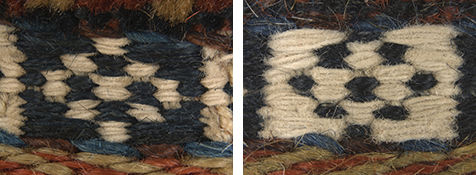The bags in the collection of William and Inger Ginsberg exemplify a range of weaving, wrapping, knotting, and braiding techniques. While the majority of the works in this exhibition were created with the weaving technique known as sumak, some textiles also feature pile (with symmetrical or asymmetrical knots) and flat-woven tapestry (kilim), as well as complex edgings, tassels, and closures. The combination of methods reveals the ingenuity and skill of the women weavers.
Although the origins of the term sumak are associated with Shemaka, a town in the Caucasus region, it no longer refers to origin, but to a general weft-wrapping practice.

Left: Sumak ground weft in white, 2/1. Center: Plain sumak, 2/1 (front). Right: Plain sumak, 2/1 (reverse)
To achieve the characteristic sumak pattern, the weaver wraps what is called "extra-weft" thread around two warp threads and then back under one (2/1 sumak, shown above) or over four and under two (4/2, not shown). The ground weft (above left), which is hidden under the extra-weft wrapping, constitutes the foundation and strength of the woven structure. The extra-weft wrapping (above center and right) is woven in tandem with the ground weft and forms the decoration seen on the textile. Simple weft wrapping, also a sumak technique, is executed without a ground weft.

Left: Slit tapestry and diagonal sumak red line. Center: Countered sumak, 2/1, brocaded (front). Right: Countered sumak, 2/1, brocaded (reverse)
The extra-weft threads may be wrapped around the warp threads in a variety of directions: horizontal, diagonal (above left), or vertical, adding rich textural diversity. In plain sumak, the predominant technique used in the bags on view, the wefts slant in the same direction, while countered sumak (above center and right) results in a herringbone-like texture.

Left: Complementary weft weave (front). Right: Complementary weft weave (reverse)
Most sumak is brocaded (or discontinuous), meaning that the weaver works on a limited area of the design at a time, rather than weaving across the entire width of the loom (continuous). However, some design elements of the works on view were made with complementary weft weave (above), in which the design is woven from selvage to selvage (or from one edge to the other).
Authors: Julia Carlson, Assistant Conservator, and Yael Rosenfield, Associate Conservator, Department of Textile Conservation. © 2017 The Metropolitan Museum of Art
Double saddle bag (Khorjin) (detail), ca. 1900. Northwestern Iran or Azerbaijan, Shahsevan tribe. Wool (warp and sumak weft) and cotton (ground weft); sumak extra weft wrapping (front) and weft-faced plain weave with pattern in brocaded weft (back), 52 x 20 in. (132.1 x 50.8 cm). The Metropolitan Museum of Art, New York, Gift of Inger G. and William B. Ginsberg, 2015 (2015.490.43). Photo by Walter B. Denny